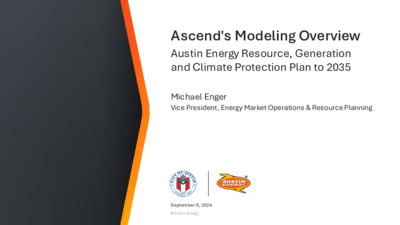Item 20: Staff Briefing & Modeling Overview for the Resource, Generation, and Climate Protection Plan — original pdf
Backup

Ascend's Modeling Overview Austin Energy Resource, Generation and Climate Protection Plan to 2035 Michael Enger Vice President, Energy Market Operations & Resource Planning September 9, 2024 © Austin Energy Modeling Progress to Date and Next Steps What we have done Where we are now What is next • Worked with EUC to finalize model inputs and assumptions (July) • Worked with EUC to finalize portfolios, scenarios and sensitivities (August) • Completing modeling runs for all portfolios and scenarios • Analyzing output metrics to quantify tradeoffs between portfolios • Provide summary of modeling results to EUC (Sept. 30) • “Office hours” for EUC deep dive into model results data (Oct. 1-4) • Austin Energy and EUC use results to refine shortlist of portfolios for further analysis 2 Austin Energy Portfolio Modeling Overview Internal Modeling Process Utilizing UPLAN and PowerSIMM modeling tools to evaluate the performance of multiple portfolios across various scenarios. 3rd Party Modeling Process Ascend’s resource planning methodology and modeling tools generate optimized portfolios based on specified constraints. Portfolio Evaluation All modeling results will be evaluated to select portfolios for further consideration. PORTFOLIO A PORTFOLIO B PORTFOLIO C PORTFOLIO D PORTFOLIO E PORTFOLIO F Shortlist of Portfolios 3 Ascend's Modeling Overview Ben Anderson Manager, Resource Planning 4 Uncertainty with Stochastic Analysis • Stochastic analysis provides a method to account for uncertainty and variability in power systems. • PowerSIMM runs a set of simulations to cover a broad range of future conditions. Simulations represent a future path with independent representations of solar, wind, load and dispatch decisions. • Outputs show a range of values for important variables such as costs, renewable generation, GHG emissions. Historic Solar Output Simulated Solar Output 5 Ascend Models Used for Austin Energy's Resource Generation Plan Work Capacity Expansion Model • Creates optimized portfolios based on user-defined constraints • Software outputs technology mix that minimizes total portfolio costs while honoring given constraints Production Cost Model • Calculates cost, emissions, and reliability metrics for optimized portfolios from the Capacity Expansion Model results • Provides mean (average) values as well as P5 and P95 probability values to show the range of possibilities Ascend Models use the same assumptions discussed with EUC in July 2024 6 Optimized Portfolio Descriptions Portfolio A Portfolio B Meets emissions and renewable energy targets, while keeping a local reliable system and minimizing transmission congestion price spikes in Austin Same as Portfolio A, but without any new natural gas or hydrogen burning plants. Provides a path to zero emissions not dependent on clean hydrogen availability Portfolio C Portfolio D Lowest cost portfolio that maintains a local reliable system and avoids transmission congestion Same as Portfolio A, but builds more local, firm capacity to ensure reliability All portfolios use max demand side management projections from DNV study 7 Portfolio Constraints A B C D Coal-Free Portfolio: FPP is not included in the portfolio (assumes retirement 12/31/2024) Carbon-Free (annual emissions requirement): Starting with 2023 carbon emissions, ramp down linearly to zero in 2035 65% Renewable (annual renewable energy requirement): Ensure renewable energy production is at least 65% of load in 2027 and beyond Green Hydrogen (conversion requirement): All new and existing natural gas plants convert to green H2 fuel in the 2030s Local Reliability (Load Zone Price Separation requirement): Ensure local firm capacity (ELCC adjusted) plus import capacity exceeds annual peak load Enhanced Local Reliability: Ensure local firm capacity (ELCC adjusted) plus import capacity exceeds annual peak load with 15% margin No New Natural Gas or Hydrogen: Prevents new natural gas or hydrogen units from satisfying local reliability requirement Reduced Natural Gas Dispatch (REACH requirement): Applies a REACH adder to existing natural gas plants and retires the units at the end of 2034 No Fuel Restrictions: Allows continued operation of natural gas plants without hydrogen conversion 8 Next Steps • Finalize model results for four Ascend portfolios • Compare Ascend model results to UPLAN model results for 13 AE/EUC portfolios • Provide summary of model results for 9/30 EUC meeting • Develop final report 9 Questions? 10